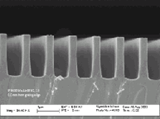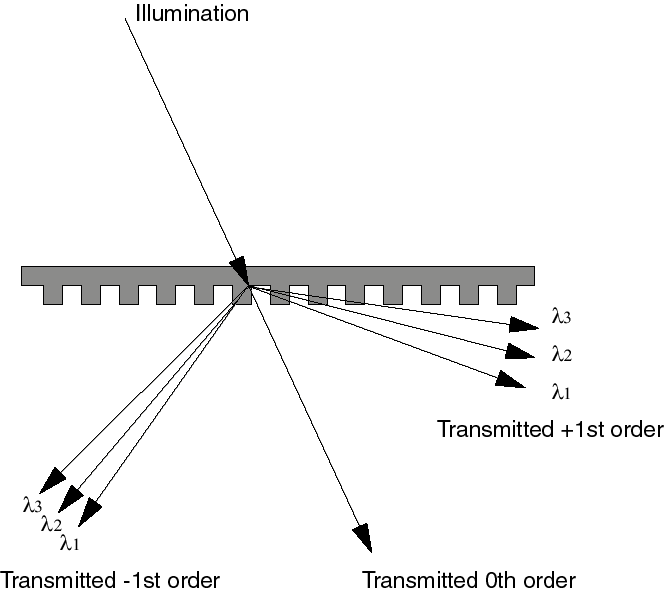Grating FAQ
Ibsen fused silica transmission gratings are gratings that are structured directly into the surface of a fused silica substrate and comprise no other materials than fused silica. They are essentially a binary structure that is monolithically attached to the fused silica substrate. A SEM picture example of a typical grating is shown here:

We pattern our gratings by 2-beam interferometry (also known as holographically) or lithographically, initially into photoresist, which is then used as an etch mask to transfer the grating pattern into the fused silica by Reactive Ion Etching (RIE). Every grating is thus a high fidelity, high integrity master, not a replica.
Grating equation:
m · λ = Λ · (sin θI + sin θD)
where:
m is the m’th diffraction order
λ is the wavelength of the illumination
Λ is the grating period
θI is the incidence angle of the illumination
θD is the diffraction angle of the illumination for the m’th diffraction order,
with respect to the following schematic:
Reflection gratings are typically composed of a substrate material (typically a glass), an epoxy or photoresist into which the grating is profiled, and finally a metallic coating on top. All grating types can be made most efficient when optimized for Littrow (Bragg) angle of incidence, which for reflection gratings means that the light is retro-reflected, while transmission gratings have the output separated from the input. Thus, reflection gratings are most convenient when retro-reflection is desired (such as laser cavity feedback), whereas transmission gratings are most convenient for most other applications (such as spectroscopy, pulse compression and transmission optical devises.)
Transmission optics in general, and transmission gratings in particular, are much easier to align that their reflective counterparts. The following technical note explains why this is the case: Why are transmission gratings less angle sensitive than reflection gratings?
Surface relief, fused silica transmission gratings are monolithically integrated into the fused silica substrate surface, and thermally and environmentally just as stable as the blank fused silica substrate. VPH gratings are recorded into a gelatin material, sandwiched between 2 substrates with the edges sealed, as the gelatin material is environmentally instable. The temperature handling capability of gelatin-based VPH gratings is little more than 100 degrees C, while fused silica transmission gratings can withstand over 1000 degrees C.
The diffraction efficiency of surface relief gratings is 3 times less sensitive to angle of incidence variation than thick VPH gratings. This is fundamental (can be derived from Kogelnik’s original grating analysis work), and related to the refractive index modulation of the gratings – see for example “Dielectric surface-relief gratings with high diffraction efficiency” by Kiyoshi Yokomori, Applied Optics / Vol. 23, No. 14 / 15 July 1984.
For a narrow bandwidth, fused silica transmission gratings can be designed to theoretically have over 99% efficiency, for a single (TE-(s) or TM(p)) polarization, or even for both polarizations simultaneously. For more broad bandwidths there is a tradeoff between the spectral width and both the average and peak efficiency that can be achieved. For grating with bandwidths of an octave ( i.e. where the end wavelength is double the start wavelength) or more, fused silica transmission gratings can typically have 75% average efficiency. Narrowband gratings (up to half an octave) can typically have 90% average efficiency or more.
While the micro-structured grating surface should not be physically touched, the fused silica-based grating structure can handle most chemical cleaning. Bath-based cleaning processes can be established for a simple acetone – IPA – DI water clean, but the gratings can also handle detergent, moderate ultrasound, acid or alkaline chemicals.
For periodic cleaning requirements in the laboratory. We recommend the commercial cleaning solution called “First Contact”. This cleaning product is effective for many optics cleaning requirements. For further information on First Contact, please see the manufacturer’s web-site: http://photoniccleaning.com.
Transmission optics in general, and transmission gratings in particular, are much easier to align that their reflective counterparts. The following technical note explains why this is the case: Why are transmission gratings less angle sensitive than reflection gratings?
We make gratings for the entire transmission range of fused silica, which starts below 200 nm and goes beyond 2000 nm. The plot below show the UV applicability of UV grade fused silica material (and thus UV fused silica transmission gratings) – here shown as the external transmission (i.e. there is approx. 8% surface Fresnel reflection loss) of a 6.35 mm thick substrate.

Fused silica transmission gratings can handle just as much power and energy as blank fused silica substrates. Quantitative values depend on wavelength and pulse length. For CW illumination our gratings have been used at more than 400 kW/cm2, while with fs lasers our gratings have been used at more than 20 TW/cm2. Click here for more information about high power gratings.
We utilize holographic stepper and lithography stepper based production equipment for cost-effective, high volume production of gratings with sizes up to approx. 50 mm x 50 mm, and we are able to fabricate grating sizes up to 100-120 mm dimensions.
Fused silica transmission gratings can handle over 1000 degrees C. The CTE of fused silica is very low (0.5×10-6/°C) so the grating period is very insensitive to temperature change. Furthermore, as the change of the refractive index of fused silica with temperature also is very low (1.28×10−5/°C at 20 degrees C), the diffraction efficiency variation with respect to temperature is also negligible.
You can read more in our white paper on fused silica transmission gratings: White-paper-Fused-Silica-Transmission-Gratings
We provide an online grating equation calculator. Click here
Want to know more?
For further information see below.
Ask the experts
Do you want to discuss your grating project with one of our experts? Please fill out the form, and we will contact you as soon as possible.
Visit our grating product pages
Browse our transmission grating products.